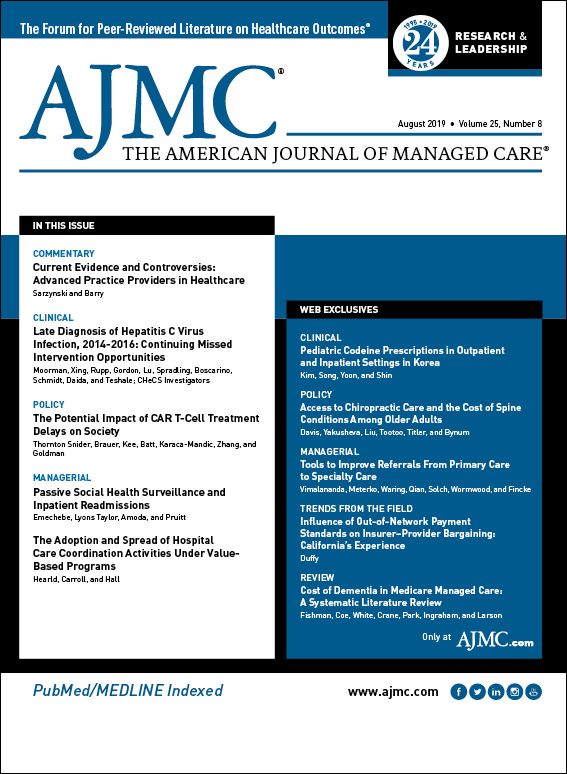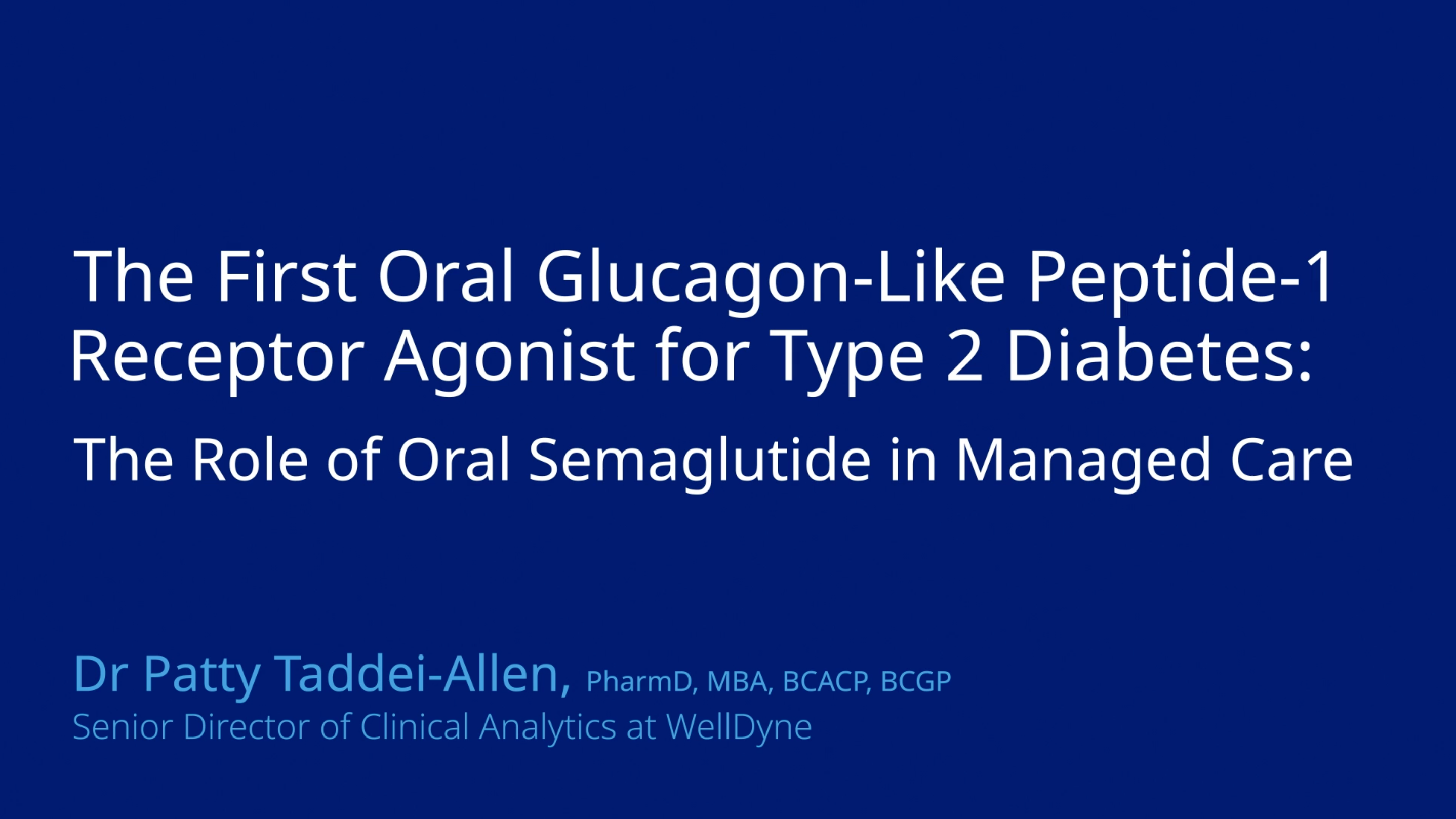Publication
Article
The American Journal of Managed Care
Late Diagnosis of Hepatitis C Virus Infection, 2014-2016: Continuing Missed Intervention Opportunities
Author(s):
Late hepatitis C virus infection diagnosis points to a need for earlier screening and treatment before the onset of severe liver disease leading to high cost and diminished outcomes.
ABSTRACT
Objectives: Chronic hepatitis C virus (HCV) infection is typically asymptomatic until severe liver disease occurs and even then can remain undiagnosed for some time; thus, screening and treatment of asymptomatic persons are needed to prevent poor outcomes. In a previous analysis of data from between 2006 and 2011, we found that 17% of newly diagnosed HCV infections in 4 large health systems were among persons with cirrhosis and/or end-stage liver disease, termed “late diagnosis.” We sought to determine the proportion with late diagnosis during 2014-2016, after release of CDC baby boomer (1945-1965 birth cohort) testing guidelines in 2012.
Study Design: The cohort was based on analysis of electronic health records and administrative data of about 2.7 million patients visiting the same healthcare systems during 2014-2016.
Methods: Among persons with newly diagnosed chronic HCV infection during 2014-2016, we analyzed data collected up to January 1, 2017.
Results: Among 2695 patients with newly diagnosed HCV infection, 576 (21.4%) had late diagnosis. Most were born between 1945 and 1965 (n = 1613 [59.9%]), and among these, 27.6% had late diagnosis. Patients with versus without late diagnosis had equally lengthy prediagnosis observation in the health systems (mean and median, 9.1 and 9.1 vs 8.3 and 7.8 years, respectively) but were more likely to have a postdiagnosis hospitalization (32.5% vs 12.5%; P <.001) with greater number of hospital days (358.8 vs 78.5 per 100 person-years; P <.001).
Conclusions: More than one-fifth of patients with newly diagnosed HCV infection during 2014-2016—and more than a quarter of those born between 1945 and 1965—had late diagnosis despite many years of in-system care, an increase of 5 percentage points since 2006-2011, after the interim initiation of age-based screening recommendations. Our data highlight missed opportunities for diagnosis and therapeutic intervention before the onset of severe liver disease, which is associated with high cost and diminished outcomes.
Am J Manag Care. 2019;25(8):369-374Takeaway Points
Chronic hepatitis C virus (HCV) infection is typically silent until liver disease is advanced; thus, screening and treatment of asymptomatic persons are needed.
- More than one-fifth of patients with newly diagnosed HCV from 2014 to 2016 in 4 large health systems—and more than a quarter among those born between 1945 and 1965, who are recommended for screening—had diagnosis concurrent with advanced liver disease despite many years of prior care, often with laboratory evidence of hepatic inflammation beginning several years prior to initial HCV diagnosis.
- These findings suggest a need for earlier screening and treatment, before the onset of severe liver disease, which is associated with high costs and diminished outcomes.
Chronic hepatitis C virus (HCV) infection is typically asymptomatic for many years after primary infection until severe liver disease occurs, and even advanced liver disease may remain undiagnosed for some time; thus, screening and subsequent treatment of asymptomatic persons are needed to prevent poor outcomes. HCV is the most commonly reported bloodborne infection in the United States, with more than 2 million persons estimated to be currently infected.1 The economic and health burdens for patients with severe liver disease are high,2 and treatment of HCV infection at all stages of disease has been demonstrated to be cost-effective.3 All persons with HCV infection are recommended for treatment, with cure rates well over 90% typically achieved with 12 weeks of all-oral therapy.4
Prompt treatment saves lives, but many barriers remain, and this can only be accomplished when infection has been detected and infected patients have been linked to care and treatment.5-7 Updated CDC baby boomer (1945-1965 birth cohort) testing guidelines were released in 2012.8,9 The rationale for this recommendation included the high prevalence of persons with hepatitis C born during these years, the estimated 45% to 85% of persons with HCV infection who do not know they are infected, reports that testing based solely on elevated alanine aminotransferase (ALT) levels is estimated to miss 50% of chronic infections, and the availability of highly effective curative therapy.8,9 If widely implemented, this 1-time test of those born between 1945 and 1965 was predicted to identify 800,000 US infections and to lead to treatment that could avert more than 120,000 HCV-related deaths and save an estimated $1.5 billion to $7 billion in liver disease—related costs.8,9 Although testing has increased since the recommendation, the overall proportion of persons tested in this age group remains quite low,10-13 and recent data are lacking to describe whether increased testing has had an impact on the prevalence of late diagnosis in the United States. Current discussion has included proposals for further expansion of testing.6,7,14
In a previous analysis of data from the Chronic Hepatitis Cohort Study (CHeCS) during 2006-2011, we found that 17% of new HCV diagnoses were among persons who had already progressed to cirrhosis and/or end-stage liver disease (ESLD).15 We sought to examine whether the frequency of these conditions at the time of HCV diagnosis had changed during 2014-2016, after the release of the CDC’s baby boomer birth cohort testing guidelines in 2012.8
METHODS
Criteria for inclusion in and composition of the CHeCS cohort, as well as details of the database created, have been summarized in previous reports.8,16-18 Briefly, the cohort was based on analysis of electronic health records (EHRs) and administrative data of about 2.7 million patients 18 years or older who had a clinical service (ie, outpatient or inpatient, emergency department, or laboratory visit) provided on or after January 1, 2006, at 1 of 4 integrated healthcare systems: Geisinger Health System in Danville, Pennsylvania, which serves approximately 2.6 million Pennsylvania residents in 44 counties; Henry Ford Health System in Detroit, Michigan, which serves more than 1 million southeastern Michigan residents; Kaiser Permanente Northwest in Portland, Oregon, which serves about 500,000 members; and Kaiser Permanente of Honolulu, Hawaii, which serves about 220,000 persons, or approximately one-sixth of Hawaii residents. CHeCS follows the guidelines of HHS regarding the protection of human subjects. The study protocol was approved and is renewed annually by the institutional review board at each participating site. Patients were considered to have confirmed chronic HCV infection based principally on laboratory test results and secondarily on International Classification of Diseases, Ninth Revision, Clinical Modification (ICD-9-CM) criteria. EHR data and administrative data were collected for each cohort patient and supplemented with individual chart review by trained data abstractors, who also reviewed and verified chronic HCV infection from EHR data. Data collected included patient demographics, medical encounters, treatment data, and laboratory, radiology, and biopsy results.
Among persons with newly diagnosed abstractor-confirmed chronic HCV infection during 2014-2016 at CHeCS sites, we analyzed retrospective and prospective EHR and administrative data from the patient’s first-ever health system visit to January 1, 2017, to determine the frequency of having severe liver disease conditions that might develop after many years of chronic HCV infection, within 3 months before to 12 months after initial HCV diagnosis, termed “late diagnosis.”15 Severe liver disease was defined, as in our previous study, as having cirrhosis (mean FIB-4 score [based on ALT, aspartate aminotransferase, and platelet values collected within 7 days of each other] >5.88 or liver biopsy indicating cirrhosis,19 with the addition of transient elastography score >12.5 kPa20—a procedure that had not been widely in use during the earlier time period) or a diagnosis of ESLD.15 ESLD was defined as having an ICD-9/ICD-10 diagnosis or procedure code indicating liver transplant, hepatocellular carcinoma, liver failure, hepatic encephalopathy, portal hypertension, esophageal varices, other gastroesophageal hemorrhage, ascites, or other sequelae of chronic liver disease.15,19 As in the earlier analysis, date of initial HCV diagnosis was defined as the earliest of (1) an EHR report of a positive laboratory test for hepatitis C antibody or RNA or (2) an HCV-related diagnostic or procedure code. To mirror the previous report, analysis was restricted to patients with at least 12 months of observation time after initial HCV diagnosis to allow adequate time post diagnosis for detection of severe liver disease.15
For comparisons of characteristics of persons with and without late diagnosis, SAS procedure FREQ with χ2 tests was used to compare categorical variable percentages, and t tests were used to compare means of continuous variables. A P value of <.05 was considered significant. A stepwise multivariate logistic model comparing all demographic factors by late diagnosis status controlling for birth year, sex, and race was run using SAS (SAS Institute; Cary, North Carolina) to provide adjusted values based on the Wald χ2 test.
RESULTS
Among 4064 patients with HCV infection first diagnosed during 2014-2016, we again excluded those with initial HCV diagnosis prior to their first CHeCS health system visit (n = 1023 [25.2%]) for whom liver disease status at initial diagnosis could not be ascertained. To minimize confounding we conducted a separate analysis for those with other bloodborne pathogen coinfections, who are recommended for HCV screening, and excluded them from further analysis. Among patients who had coinfection with hepatitis B virus (n = 25 [0.6%]), 13 (52.0%) had severe liver disease at diagnosis; among those with HIV (n = 42 [1.0%]), 10 (23.8%) had severe liver disease; and among 2 (0.1%) patients with both coinfections, 1 had severe liver disease. We also excluded patients with less than 12 months of follow-up after initial HCV diagnosis (n = 277 [6.8%]).
Of the remaining 2695 patients, 576 (21.4%) were found to have concurrent severe liver disease at diagnosis (Table 115,19,20), with similar proportions of late diagnosis among the 387 (14.4%) given a diagnosis of HCV within their first 6 months in the health system versus later (23.8% vs 21.0%). The proportion with late diagnosis (19.5%) was substantial even among those excluded due to their having less than 12 months of postdiagnosis follow-up.
Most patients given a diagnosis during 2014-2016 were born between 1945 and 1965 (n = 1613 [59.9%]), and among these, 27.6% had late diagnosis. Late diagnosis was less frequent (10.0%) among the patients born after 1965 and more frequent (39.0%) among the small proportion born before 1945. Late diagnosis was more common among men than women (23.6% vs 18.3%), black than white patients (26.2% vs 19.4%), and those with public versus private insurance (Medicare, 29.7%; Medicaid, 24.8%; private, 18.2%). In an analysis of demographic factors adjusted for birth year, race, and gender, differences by birth year, gender, and insurance were significant (Table 115,19,20).
Both patients with and without late diagnosis had lengthy observation (mean and median, 9.1 and 9.1 vs 8.3 and 7.8 years, respectively) in the health systems prior to their HCV diagnosis. During this prediagnosis period, most of those with late diagnosis had prior healthcare visits (80.0%) and many had emergency department visits (46.5%) and prior hospitalizations (24.1%). Many had elevations in ALT levels (22.9%; first experienced on average 7 years earlier) (Table 215,19,20). About a quarter of patients with late diagnosis and 13% of those without late diagnosis had liver function and platelet count laboratory tests available for FIB-4 calculation,11 first available on average 5 years prior to HCV diagnosis for both groups. The highest FIB-4 in the period more than 1 year before initial HCV diagnosis was sufficiently elevated to indicate possible (>3.25) or likely (>5.88) hepatic cirrhosis among 34% of those with and 8% of those without late diagnosis, with first elevations at those levels occurring, on average, 5 years prior to HCV diagnosis for both groups. After HCV diagnosis, those with late diagnosis were more likely to have a hospitalization (32.5% vs 12.5%; P <.001) with a greater number of hospital days (358.8 vs 78.5 per 100 person-years; P <.001).
DISCUSSION
More than one-fifth of CHeCS patients with newly diagnosed HCV during 2014-2016—and more than a quarter of those born between 1945 and 1965—had severe liver disease concurrent with initial HCV diagnosis despite many years of care in the health systems, an increase of 5 percentage points since 2006-201115 after the interim initiation of age-based screening recommendations.8 Many patients, particularly those with late diagnosis, had laboratory markers of liver inflammation beginning several years prior to their initial HCV diagnosis, which did not prompt screening and diagnosis with the opportunity for treatment at a likely earlier disease stage.
Although late diagnosis was less common among those born after 1965, a higher proportion of persons with newly diagnosed HCV from 2014 to 2016 were in this age group than in the earlier analysis (37% vs 21%), probably reflecting national increases in HCV transmission and detection among younger age groups, likely related to the opioid epidemic.14,21 Most late diagnoses (82.5%) occurred among persons born in or before 1965, more frequently among men and those with public insurance. The 2012 recommendations for testing of persons born between 1945 and 1965 and increased awareness of HCV have led to more widespread—although still vastly incomplete—testing and identification of infection.7,10-13 However, our data reflect national trends in continued disease progression and increasing morbidity among persons with long-term infection,12,22 including those whose HCV is not yet diagnosed. With the aging of the infected population, the proportion of persons with severe liver disease may continue to increase without greater access to treatment.
Limitations
This update has many of the same limitations as the earlier analysis.15 Diagnosis codes selected to define late diagnosis were of sufficient severity to correspond with decompensated liver disease rather than mild-to-moderate liver disease. This highly conservative definition of late diagnosis also likely included some patients with advanced HCV infection in the group without late diagnosis. About a quarter of new HCV cases had been previously diagnosed outside the health systems, and patients’ disease status at diagnosis could not be ascertained. It is possible that we missed detection of some outside-system HCV diagnoses, despite lengthy observation time from first health system encounter to first EHR evidence of HCV diagnosis. Our use of a conservative FIB-4 cutoff level for cirrhosis could be anticipated to miss some patients with advanced fibrosis, thus leading to an underestimate. However, the FIB-4 cutoff for cirrhosis of greater than 5.88 was derived and validated specifically in the study cohort and chosen to maximize positive predictive value.20
CONCLUSIONS
This study supports the finding that patients with undiagnosed cirrhosis are being followed in health systems for years prior to receiving a diagnosis of HCV, but waiting until it is clear that severe liver disease is present is a failed strategy for reducing morbidity and health costs. Although morbidity and mortality from liver disease and related conditions have been demonstrated to decrease after successful treatment for patients at all stages of disease,23 patients who have already progressed to cirrhosis still remain at risk for hepatocellular carcinoma24 and those with manifestations of ESLD, such as severe portal hypertension, may not experience improvements in those conditions,25 leading to significant economic and health disease burden.3-7 These patients are losing the opportunity to access the healthcare appropriate for those with cirrhosis, such as vaccinations, screening for liver cancer and esophageal varices, and counseling about risks of common medications or foods in those with cirrhosis. Payers should have a role in facilitating recommended testing for HCV infection. Our data highlight the continuing missed opportunities for diagnosis and therapeutic intervention before the onset of severe liver disease, when treatment may involve high costs and diminished outcomes.
Acknowledgments
The Chronic Hepatitis Cohort Study Investigators include the following investigators and sites: Eyasu H. Teshale, Philip R. Spradling, Anne C. Moorman, Jian Xing, and Yuna Zhong, Division of Viral Hepatitis, National Centers for HIV, Viral Hepatitis, STD, and TB Prevention, CDC, Atlanta, Georgia; Stuart C. Gordon, David R. Nerenz, Mei Lu, Lois Lamerato, Jia Li, Loralee B. Rupp, Nonna Akkerman, Talan Zhang, Sheri Trudeau, Yueren Zhou, and Kuan-Han Wu, Henry Ford Health System, Detroit, Michigan; Joseph A. Boscarino, Zahra S. Daar, and Robert E. Smith, Department of Epidemiology and Health Services Research, Geisinger Clinic, Danville, Pennsylvania; Yihe G. Daida, Connie Mah Trinacty, Jonathan W. Lai, and Carmen P. Wong, Center for Integrated Health Care Research, Honolulu, Hawaii; and Mark A. Schmidt and Judy L. Donald, The Center for Health Research, Kaiser Permanente Northwest, Portland, Oregon.Author Affiliations: Division of Viral Hepatitis, National Center for HIV, Viral Hepatitis, STD, and TB Prevention, CDC (ACM, JX, PRS, EHT), Atlanta, GA; Henry Ford Health System (LBR, SCG, ML), Detroit, MI; Wayne State University School of Medicine (SCG), Detroit, MI; Geisinger Clinic (JAB), Danville, PA; Kaiser Permanente Northwest (MAS), Portland, OR; Center for Integrated Health Care Research (YGD), Honolulu, HI.
Source of Funding: Henry Ford Health System receives funding for the Chronic Hepatitis Cohort Study (CHeCS) from the CDC and from Gilead Sciences. CHeCS was previously funded through May 2016 by the CDC Foundation, which received grants from AbbVie; Genentech, A Member of the Roche Group; Gilead Sciences; Janssen Pharmaceuticals; and Vertex Pharmaceuticals; past partial funders include Bristol-Myers Squibb. Granting corporations do not have access to CHeCS data and do not contribute to data analysis or writing of manuscripts.
The findings and conclusions in this report are those of the authors and do not necessarily represent the official position of the CDC.
Author Disclosures: Ms Rupp and Dr Lu have received research grant funding to their institution from Gilead Sciences and Intercept Pharmaceuticals and have received travel support from Gilead and Intercept to present posters at The Liver Meeting 2018, sponsored by the American Association for the Study of Liver Diseases. Dr Gordon has received grant/research support from AbbVie Pharmaceuticals, Conatus, CymaBay, Gilead, Intercept, and Merck; has received speaking and lecture fees from Dova Pharmaceuticals; is an ad hoc advisory board member for Dova and Intercept; and receives royalties from UpToDate. Dr Boscarino has received grants from Gilead and Intercept. Dr Schmidt has received institutional research grant support from Gilead and Intercept. Dr Daida reports that her institution received a grant from Gilead to support the submitted work. The remaining authors report no relationship or financial interest with any entity that would pose a conflict of interest with the subject matter of this article.
Authorship Information: Concept and design (ACM, JAB, MAS, YGD, EHT); acquisition of data (ACM, LBR, SCG, ML, JAB, MAS, YGD, EHT); analysis and interpretation of data (ACM, JX, PRS); drafting of the manuscript (ACM, PRS, JAB, EHT); critical revision of the manuscript for important intellectual content (ACM, JX, LBR, SCG, ML, PRS, JAB, MAS, YGD, EHT); statistical analysis (ACM, JX); provision of patients or study materials (LBR, SCG, ML, JAB); obtaining funding (LBR, SCG, ML, JAB, EHT); administrative, technical, or logistic support (ACM, JAB, EHT); and supervision (JAB, EHT).
Address Correspondence to: Anne C. Moorman, MPH, Division of Viral Hepatitis, National Center for HIV, Viral Hepatitis, STD, and TB Prevention, CDC, Mailstop G-37, Atlanta, GA 30329. Email: Amoorman@cdc.gov.REFERENCES
1. Hofmeister MG, Rosenthal EM, Barker LK, et al. Estimating prevalence of hepatitis C virus infection in the United States, 2013-2016. Hepatology. 2019;69(3):1020-1031. doi: 10.1002/hep.30297.
2. Stepanova M, DeAvila L, Afendy M, et al. Direct and indirect economic burden of chronic liver disease in the United States. Clin Gastroenterol Hepatol. 2017;15(5):759-766.e5. doi: 10.1016/j.cgh.2016.07.020.
3. Linas BP, Nolen S. A guide to the economics of hepatitis C virus cure in 2017. Infect Dis Clin North Am. 2018;32(2):447-459. doi: 10.1016/j.idc.2018.02.013.
4. American Association for the Study of Liver Diseases; Infectious Diseases Society of America. HCV Guidance: Recommendations for Testing, Managing, and Treating Hepatitis C website. hcvguidelines.org. Accessed March 10, 2019.
5. Mera J, Reilley B, Leston J, Stephens D. In a critical state: ongoing barriers to treatment for hepatitis C virus (HCV). Am J Med. 2019;132(5):547-549. doi: 10.1016/j.amjmed.2018.10.031.
6. Linthicum MT, Gonzalez YS, Mulligan K, et al. Value of expanding HCV screening and treatment policies in the United States. Am J Manag Care. 2016;22(6 spec no):SP227-SP235.
7. Weiner J, Linas B. Cost-effective screening and treatment of hepatitis C. Leonard Davis Institute of Health Economics website. ldi.upenn.edu/sites/default/files/pdf/LDI_CHERISH_Brief_Hepatitis_C_Sept2018.pdf. Published September 2018. Accessed March 10, 2019.
8. Smith BD, Morgan RL, Beckett GA; CDC. Recommendations for the identification of chronic hepatitis C virus infection among persons born during 1945-1965 [erratum in MMWR Recomm Rep. 2012;61(43):886]. MMWR Recomm Rep. 2012;61(RR-4):1-32.
9. People born 1945-1965 (baby boomers). CDC website. cdc.gov/hepatitis/populations/1945-1965.htm. Updated November 2, 2018. Accessed March 10, 2019.
10. Barocas JA, Wang J, White LF, et al. Hepatitis C testing increased among baby boomers following the 2012 change to CDC testing recommendations. Health Aff (Millwood). 2017;36(12):2142-2150. doi: 10.1377/hlthaff.2017.0684.
11. Rodriguez CV, Rubenstein KB, Linas B, Hu H, Horberg M. Increasing hepatitis C screening in a large integrated health system: science and policy in concert. Am J Manag Care. 2018;24(5):e134-e140.
12. Kasting ML, Giuliano AR, Reich RR, et al. Hepatitis C virus screening trends: a 2016 update of the National Health Interview Survey. Cancer Epidemiol. 2019;60:112-120. doi: 10.1016/j.canep.2019.03.007.
13. Bian J, Schreiner AD. Population-based screening of hepatitis C virus in the United States. Curr Opin Gastroenterol. 2019;35(3):177-182. doi: 10.1097/MOG.0000000000000520.
14. Gordon SC. Hepatitis C virus detection and treatment in rural communities. Gastroenterol Hepatol (N Y). 2018;14(12):720-722.
15. Moorman AC, Xing J, Ko S, et al; CHeCS Investigators. Late diagnosis of hepatitis C virus infection among patients in the Chronic Hepatitis Cohort Study (CHeCS): missed opportunities for intervention. Hepatology. 2015;61(5):1479-1484. doi: 10.1002/hep.27365.
16. Moorman AC, Gordon SC, Rupp LB, et al; Chronic Hepatitis Cohort Study Investigators. Baseline characteristics and mortality among people in care for chronic viral hepatitis: the Chronic Hepatitis Cohort Study. Clin Infect Dis. 2013;56(1):40-50. doi: 10.1093/cid/cis815.
17. Lu M, Rupp LB, Moorman AC, et al. Comparative effectiveness research of Chronic Hepatitis B and C Cohort Study (CHeCS): improving data collection and cohort identification. Dig Dis Sci. 2014;59(12):3053-3061. doi: 10.1007/s10620-014-3272-6.
18. Abara WE, Moorman AC, Zhou Y, et al; CHeCS Investigators. The predictive value of International Classification of Disease codes for chronic hepatitis C virus infection surveillance: the utility and limitations of electronic health records. Popul Health Manag. 2018;21(2):110-115. doi: 10.1089/pop.2017.0004.
19. Li J, Gordon SC, Rupp LB, et al; Chronic Hepatitis Cohort Study (CHeCS) Investigators. The validity of serum markers for fibrosis staging in chronic hepatitis B and C. J Viral Hepat. 2014;21(12):930-937. doi: 10.1111/jvh.12224.
20. Tapper EB, Castera L, Afdhal NH. FibroScan (vibration-controlled transient elastography): where does it stand in the United States practice. Clin Gastroenterol Hepatol. 2015;13(1):27-36. doi: 10.1016/j.cgh.2014.04.039.
21. Hepatitis C virus: figure 4.2: incidence of acute hepatitis C, by age group—United States, 2001-2016. CDC website. cdc.gov/hepatitis/statistics/2016surveillance/index.htm#tabs-6-7. Updated April 16, 2018. Accessed March 10, 2019.
22. Udompap P, Mannalithara A, Heo NY, Kim D, Kim WR. Increasing prevalence of cirrhosis among U.S. adults aware or unaware of their chronic hepatitis C virus infection. J Hepatol. 2016;64(5):1027-1032. doi: 10.1016/j.jhep.2016.01.009.
23. Simmons B, Saleem J, Heath K, Cooke GS, Hill A. Long-term treatment outcomes of patients infected with hepatitis C virus: a systematic review and meta-analysis of the survival benefit of achieving a sustained virological response. Clin Infect Dis. 2015;61(5):730-740. doi: 10.1093/cid/civ396.
24. van der Meer AJ, Feld JJ, Hofer H, et al. Risk of cirrhosis-related complications in patients with advanced fibrosis following hepatitis C virus eradication. J Hepatol. 2017;66(3):485-493. doi: 10.1016/j.jhep.2016.10.017.
25. Grgurevic I, Bozin T, Madir A. Hepatitis C is now curable, but what happens with cirrhosis and portal hypertension afterwards? Clin Exp Hepatol. 2017;3(4):181-186. doi: 10.5114/ceh.2017.71491.











